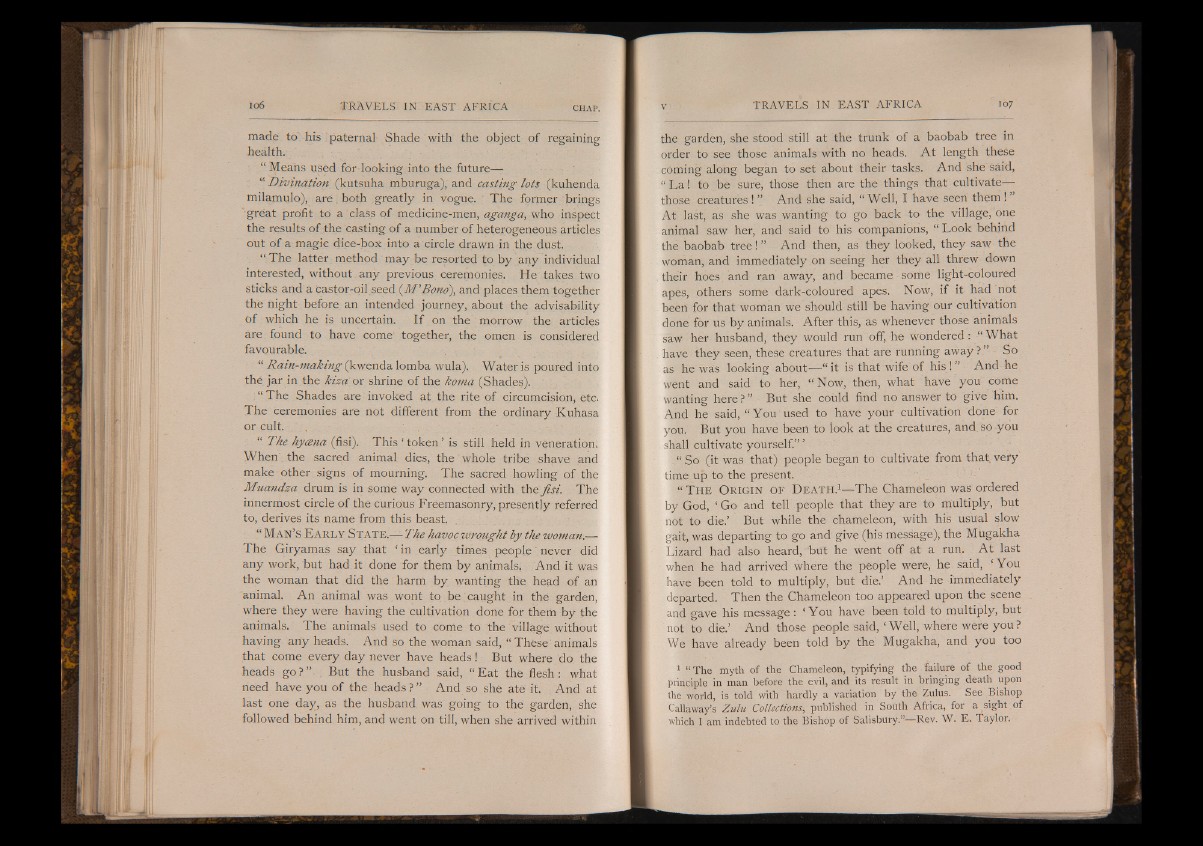
made to' his paternal Shade with the object of regaining
health.
“ Means used for looking into the future—
“ Divination (kutsuha mburuga), and casting lots (kuhenda
milamulo), a re. both greatly in vogue. The former brings
"great profit to a class of medicine-men, aganga, who inspect
the results of the casting of a number of heterogeneous articles
out of a magic dice-box into a circle drawn in the dust.
“ The latter method may be resorted to by any individual
interested, without any previous ceremonies. He takes two
sticks and a castor-oil seed (M'Bono), and places them together
the night before an intended journey, about the advisability
of which he is uncertain. I f on the morrow the articles
are found to have come together, the omen is considered
favourable.
“ Rain-making (kwenda lomba wula). Water is poured into
thé jar in the kiza or shrine of the koma (Shades).
: “ The Shades are invoked at the rite of circumcision, etc.
The ceremonies are not different from the ordinary Kuhasa
or Cult.
: “ The hycena (fisi). This ‘ token ’ is still held in veneration.
When' the sacred animal dies, the whole tribe shave and
make other signs of mourning. The sacred howling of the
Muandza drum is in some way connected with the fisi. The
innermost Circle of the curious Freemasonry, presently referred
to, derives its name from this beast.
“ M a n ’s E a r l y S t a t e .— The havoc wrought by the woman.—
The Giryamas say that ‘ in early times people never did
any work, but had it done for them by animals. And it was
the woman that did the harm by wanting the head of an
animal. An animal was wont to be caught in the garden,
where they were having the cultivation done for them by the
animals. The animals used to come to the village without
having any heads. And so the woman said, “ These animals
that come every day never have heads! But where do the
heads g o ? ” . , But the husband said, “ Eat the flesh : what
need have you of the heads?” And so she ate it. And at
last one day, as the husband was going to the garden, she
followed behind him, and went on till, when she arrived within
the garden, she stood still at the trunk of a baobab tree in
order to see those animals with no heads. A t length these
coming along began to set about their tasks. And she said,
“ L a ! to be sure, those then are the things that cultivate—
those creatures ! ” And she said, “ Well, I have seen them ! ”
At last, as she was wanting to go back to the village, one
animal saw her, and said to his companions, “ Look behind
the baobab tree! ” And then, as they looked, they saw the
woman, and immediately on seeing her they all threw down
their hoes, and ran away, and became some light-coloured
apes, others some dark-coloured apes. Now, if it had not
been for that woman we should still be having our cultivation
done for us by animals. After this, as whenever those animals
saw her husband, they would run off, he wondered: “ What
have they seen, these creatures that are running away ? So
as he was looking about— “ it is that wife of h is !” And he
went and said to her, “ Now, then, what have you come
wanting here ? ” But she could find no answer to give him.
And he said, “ You used to have your cultivation done for
you. But you have been to look at the creatures, and so you
shall cultivate yourself.” ’
“ So (it was that) people began to cultivate from that, very
time up to the present.
“ T h e O r i g i n o f D e a t h .1— The Chameleon was ordered
by God, ‘ Go and tell people that they are to multiply, but
not to die.’ But while the chameleon, with his usual slow
gait, was departing to go and give (his message), the Mugakha
Lizard had also heard, but he went off at a run. A t last
when he had arrived where the people were, he said, ‘ You
have been told to multiply, but die.’ And he immediately
departed. Then the Chameleon too appeared upon the scene
and gave his message: ‘ You have been told to multiply, but
not to die.’ And those people said, ‘Well, where were you?
We have already been told by the Mugakha, and you too
1 “ The myth of the Chameleon, typifying the failure of the good
principle in man before the evil, and its result in bringing death upon
the world, is told with hardly a variation by the Zulus. See Bishop
Callaway’s Zulu Collections, published in South Africa, for a sight of
which I am indebted to the Bishop of Salisbury.”— Rev. W. E. Taylor.